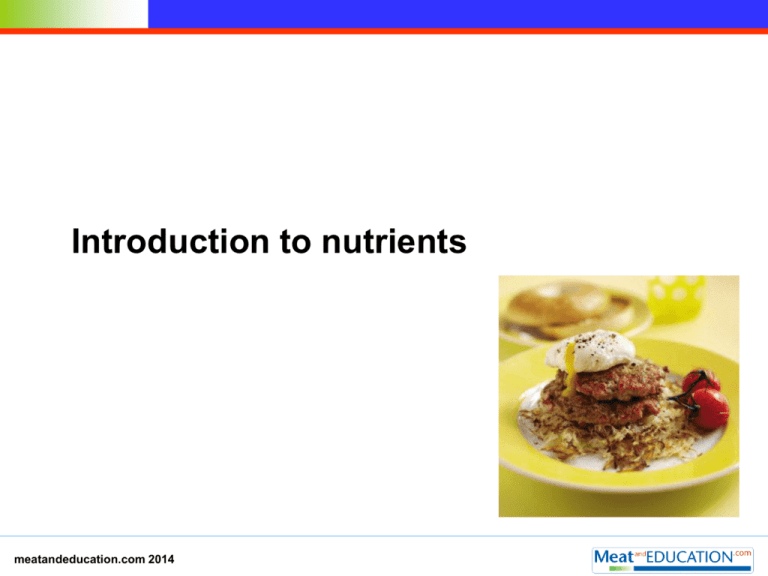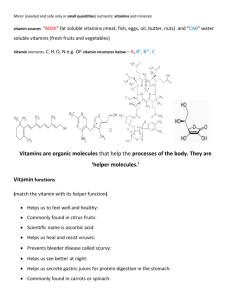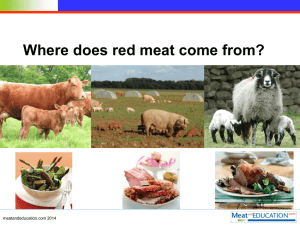Introduction to nutrients.
advertisement

Introduction to nutrients meatandeducation.com 2014 Learning objectives • To introduce macronutrients and micronutrients. • To explain the functions and sources of carbohydrate, protein and fat. • To explain the functions and sources of different vitamins and minerals. meatandeducation.com 2014 Nutrients Our body needs energy and nutrients from food and drinks to: • stay alive • be active • grow • keep warm. meatandeducation.com 2014 Nutrients Food is eaten and digested in the body to allow the absorption of energy and nutrients. There are two different types of nutrients: 1) macronutrients; 2) micronutrients. meatandeducation.com 2014 Macronutrients There are three different types of macronutrients essential for health. These are: • carbohydrate; • protein; • fat. Macronutrients are measured in grams (g). meatandeducation.com 2014 Energy Energy is provided by the carbohydrate, protein and fat present in the food and drinks we consume. It is measured in kilojoules (kJ). Energy can also be expressed as calories or kcal 1 gram of carbohydrate provides 16kJ. 1 gram of protein provides 17kJ. 1 gram of fat provides 37kJ. . meatandeducation.com 2014 Carbohydrate Carbohydrate provides the major source of energy for the body. There are three types of carbohydrate: monosaccharides, disaccahrides and polysaccharides. Carbohydrate provides 16kJ (4kcal) per gram. The two main types of carbohydrate are: 1) sugar; 2) starch. meatandeducation.com 2014 Sources of carbohydrate Some examples of food sources of the sugar type of carbohydrate are: Table sugar (sucrose) Fruit (fructose) Milk (lactose) Some examples of food sources for starchy carbohydrate are: bread meatandeducation.com 2014 rice potatoes pasta cereal Protein Protein provides amino acids (building blocks of proteins), some of which the body cannot make itself. It is needed for growth, development and repair of the body. There is an extra requirement for protein for growth in infants and children and for pregnant and breast feeding women. Protein provides 16kJ (4kcal) per gram. meatandeducation.com 2014 Sources of protein Protein is found in meat, fish, eggs, poultry and dairy foods. Protein is also found in non-meat sources, e.g. cereal products, tofu, nuts, beans and pulses. meatandeducation.com 2014 Fat Fat provides essential fatty acids (that the body cannot make itself) which are needed for health in small amounts. It also provides energy. Fat is a carrier for the important fat-soluble vitamins A, D, E and K. Fat also provides protection for the major organs in the body. One gram of fat provides 37kJ (9kcal). meatandeducation.com 2014 Fat Fat is made up of fatty acids and glycerol. Types of fatty acids include: • Saturated; • Unsaturated; - Monounsaturated; - Polyunsaturated. meatandeducation.com 2014 Sources of fat in the diet Saturated fat can be found in meat, coconut oil, palm oil, butter, ghee, lard, cream, ice cream, cheese, pastries, cakes and biscuits. Monounsaturated and polyunsaturated fat can be found in rapeseed oil, olive oil, oily fish, avocado and some margarines and low fat spreads. meatandeducation.com 2014 Micronutrients The micronutrients are divided into: • vitamins; • minerals. Micronutrients are needed in smaller amounts. These are measured in milligrams (1mg = 0.001g) and micrograms (1μg = 0.001mg). meatandeducation.com 2014 Vitamins Vitamins are found in a wide variety of foods and they have many uses within the body. There are two groups of vitamins: • Fat-soluble vitamins, e.g. vitamins A, D, E and K. • Water-soluble vitamins, e.g. B vitamins and vitamin C. meatandeducation.com 2014 Fat-soluble vitamins: Vitamin A Vitamin A is needed for the normal structure and functioning of body linings and is also involved in keeping the immune system healthy. Vitamin A is important for vision in dim lighting. Night blindness may develop if a deficiency occurs. Vitamin A is found in liver, whole milk, dark green leafy vegetables, carrots and orange coloured fruits. meatandeducation.com 2014 Fat-soluble vitamins: Vitamin D Vitamin D is needed for the absorption of calcium and phosphorus from foods which helps to keep bones healthy. A lack of vitamin D causes rickets in children, where the legs are bent, and causes osteomalacia in adults, which causes pain in the bones and muscle weakness. Most vitamin D is absorbed through the action of sunlight on our skin during the summer months. Food sources of vitamin D include oily fish, eggs, fortified breakfast cereals, red meat and margarine. meatandeducation.com 2014 Fat-soluble vitamins: Vitamin E Vitamin E acts as an antioxidant to protect the cells in our bodies against damage. Good sources of Vitamin E include plant oils such as soya, corn and olive oil, nuts, seeds and wheatgerm. meatandeducation.com 2014 Fat-soluble vitamins: Vitamin K Vitamin K is needed for the normal clotting of blood and is required for normal bone structure. Good sources include green leafy vegetables, meat and dairy products. meatandeducation.com 2014 Water-soluble vitamins: B vitamins B vitamins are water soluble and needed for the release of energy from food. There are many different B vitamins and each has a specific function in the body. The B vitamins can be found in a variety of foods, such as bread, cereals, milk, meat, eggs, and fortified breakfast cereals. meatandeducation.com 2014 Water-soluble vitamins: Vitamin C Vitamin C acts as an antioxidant and is important for the normal structure and functioning of body tissues. Vitamin C is needed for the production of collagen, an important protein which helps bones to grow and wounds to heal. It also helps the body absorb iron from non-meat sources such as vegetables. Good sources of vitamin C include citrus fruits and berries, green vegetables, peppers, tomatoes and potatoes (especially new potatoes). meatandeducation.com 2014 Minerals Minerals have many uses in the body such as: • forming bones and teeth • being part of our body fluids • helping nerves work. The amount of different minerals needed by the body changes over time. meatandeducation.com 2014 Calcium Calcium is important for the formation and maintenance of strong bones and teeth. It is also needed for the normal functioning of nerves and muscles. Calcium is required for blood clotting. Sources of calcium include milk, cheese and other dairy products, edible soft bones of fish, green leafy vegetables, fortified soya products and bread. A diet with adequate amounts of calcium will reduce the risk of developing osteoporosis. Vitamin D helps the body to absorb calcium. meatandeducation.com 2014 Sodium Sodium helps to regulate water content and the balance of electrolytes in the body. Sodium is required for the absorption of certain nutrients and water from the gut. Sodium is involved in the use of energy and the normal functioning of nerves. Most people in the UK are eating too much sodium in their diet. High intakes of sodium are linked to high blood pressure which increases the risk of stroke and coronary heart disease. Sodium is found in very small amounts in raw foods. It is often added as salt during processing, preparation, preservation and serving. meatandeducation.com 2014 Iron Iron is required for making haemoglobin in red blood cells which transport oxygen around the body. It is also required for normal metabolism and the functioning of enzymes to remove waste substances from the body. Adolescent girls and women need more iron than boys because they lose blood each month through menstruation. A lack of iron leads to iron deficiency anaemia. meatandeducation.com 2014 Sources of iron Iron is found in animal and plant sources. Iron from meat sources is easier for the body to absorb. Vitamin C helps the body to absorb iron from plants. Food sources of iron include liver, red meat, beans, nuts, dried fruits, poultry, fish, whole grains and dark green leafy vegetables. meatandeducation.com 2014 For further information and support, go to: www.meatandeducation.com meatandeducation.com 2014







